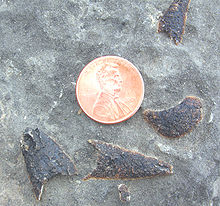Chiton
| Chiton Temporal range:
| |
|---|---|

| |
| A live lined chiton,Tonicella lineataphotographedin situ:The anterior end of the animal is to the right. | |
| Scientific classification | |
| Domain: | Eukaryota |
| Kingdom: | Animalia |
| Phylum: | Mollusca |
| Class: | Polyplacophora Blainville,1816 |
| Subgroups | |
Chitons are primitivemarinemolluscsin the classPolyplacophora(formerly the class Amphineura). There are 900 to 1,000 living species of chitons. The size ranges from 0.5 to 30 cm in length. most are quite small. All the living species are in the subclassNeoloricataand so may be called loricates Popular names are sea cradles or coat of mail shells They have a single shell that sticks to rocks, like alimpet.The shell is made of 8 hard plates that fit tightly together, overlapping one another. The shell plates are surrounded by a structure known as a girdle.
Description
[change|change source]Polyplacophora means "many plates". The plates refer to the shell, which is made of aragonite, acalcium carbonatemineral.The shell is quite flexible, and the chiton can even roll into a ball. The chiton has eight plates, and underneath the plates is amuscularfoot that moves the chiton over rocks and other structures, both in and out of the water. It also has atongue-shapedstructurecalled theradula,which has many rows of 17 teeth each. Some use it to scrapealgaeoff rocks, while others arecarnivorous,catching tinyzooplanktonand other small animals that live in shallow water.
Chitons can be less than an inch long, or up to a foot long. They come in many different colors: black, red, pink, and even blue. The shell might be shiny or dull, or smooth, hairy, scaly, or spiny depending on the species.

If a chiton was picked up and turned over, there would be noeyes,legs, or arms. There would only be a wide foot with a radula that it uses for scraping surfaces. Itsmantleis right under the shell, with the lowest part of the mantle coming out under the edge of the shell to help its foot grip the surfaces on which it clings or slides along. The part of the mantle which sticks out is called thegirdle.Like the moonsnail,the girdle mayextendout over the bottom part of the shell covering the bottom half of the chiton.
Habits
[change|change source]
Most chitons arenocturnal,so they feed at night, and hide under rocks during the day. Their main habitat is theintertidal zone.They live on hard surfaces, such as on or under rocks, or in rock crevices. Some species live quite high in theintertidal zoneand are exposed to the air and light for long periods. Others live below the tide. A few species live in deep water, as deep as 6,000 m (about 20,000 ft).
Evolutionary origins
[change|change source]
Chitons have a relatively good fossil record, stretching back 400 million years to theDevonian.[1]Before this, some organisms have been interpreted (tentatively) as stem-group polyplacophora; the record of polyplacophora stretches back to the UpperCambrian.[2]
KimberellaandWiwaxiaof the Precambrian and Cambrian may be related to ancestral polyplacophora.Mattheviais a late Cambrian polyplacophoran preserved as individual pointed valves, and sometimes considered to be a chiton.[1]The polyplacophorans may have formed when an aberrant monoplacophoran was born with multiple centres of calcification, rather than the usual one. Selection acted on the resultant conical shells to form them to overlap into protective armour. Their original cones are homologous with the tips of the plates of modern chitons.[1]
References
[change|change source]- ↑1.01.11.2Runnegar B.; Pojeta J.J. 1974. Molluscan phylogeny: the paleontological viewpoint.Science186:311–317. doi:10.1126/science.186.4161.311.PMID 17839855
- ↑Sigwart; Sutton M.D. 2007. Deep molluscan phylogeny: synthesis of palaeontological and neontological data.Proceedings of the Royal Society B:Biological sciences274:2413–2419. doi:10.1098/rspb.2007.0701.PMID 17652065.For a summary, seeThe Mollusca.University of California Museum of Paleontology.http://www.ucmp.berkeley.edu/taxa/inverts/mollusca/mollusca.php.
